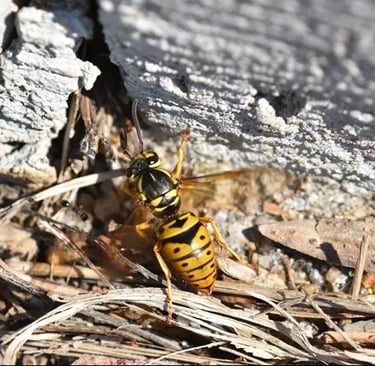Yellowjackets


Yellowjackets are found worldwide, and there are about 16 different species in the United States. Like other wasps and hornets, they are social insects having annual colonies. Only the queen lives through winter, if she survives the Spring and Summer months to start a new colony the following Spring. Depending on the species, the queen will pick an underground or aerial site to build the nest. Common places for a nest are bushes, trees, logs, wall voids, or the eaves of homes. In addition, Yellowjacket nests often have more than one entry and exit hole.
Like wasps and hornets, yellowjackets feed on sugary substances like flower nectar, fruit, and the occasional soda or sweet drink. In addition, yellowjackets consume protein in their larval stage. Workers bring insects and other protein sources back to the nest as food for the larvae. Most homeowners consider yellowjackets a dangerous pest, but their diet actually makes them an important part of our ecosystem.
Yellowjackets are very territorial. If the entrance hole to their nest is approached, they will become very aggressive. They can sting multiple times. Their stings can be very painful and people who are allergic to their venom may have a severe allergic reaction. It is also possible to become hypersensitive to yellowjacket stings after being stung just once. This sensitivity can cause a serious problem if stung again in the future.
If you believe you have yellowjackets on your property, it’s best to call Dolphin Pest Control to eliminate them. Attempting to remove or treat the nest without a professional could result in being stung multiple times. Yellowjackets will spray you with a pheromone scent causing the rest of the nestlings to chase you down very aggressively. Proper removal requires special equipment, safety precautions and often treated at night depending on the nest’s location and is best handled by a professional.
Enjoy the rest of your Summer,
Michael
Photo Credit: Pestworld.org


